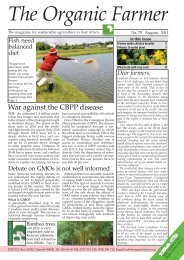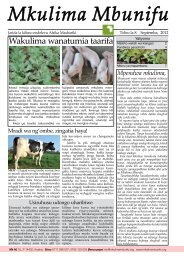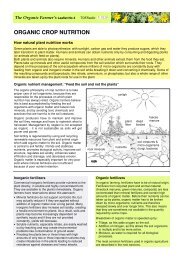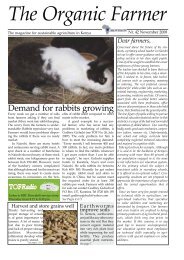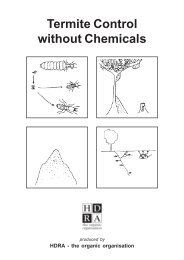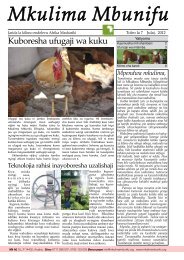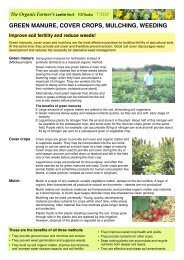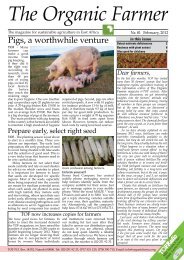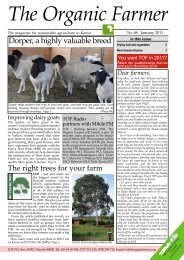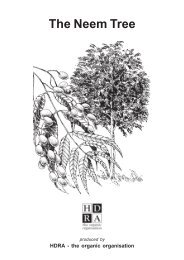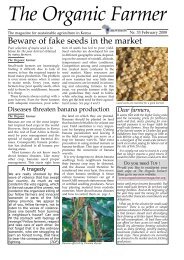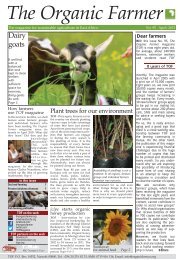TOF, Issue No 07, November 2005 - Infonet-Biovision
TOF, Issue No 07, November 2005 - Infonet-Biovision
TOF, Issue No 07, November 2005 - Infonet-Biovision
You also want an ePaper? Increase the reach of your titles
YUMPU automatically turns print PDFs into web optimized ePapers that Google loves.
8 The Organic Farmer Nr. 7 <strong>No</strong>vember <strong>2005</strong><br />
The beans that can reduce malnutrition<br />
Soya beans are of great value. They<br />
have the highest concentration of<br />
proteins, vitamins and minerals of<br />
any crop.<br />
By The Organic Farmer<br />
Despite its high nutritional value,<br />
many farmers in Kenya and many<br />
other countries in Africa do not<br />
grow soya beans. This is mainly<br />
because most people do not know its<br />
value. Another reason is that unlike<br />
other food crops such as maize and<br />
beans, it needs processing into flour<br />
before it is consumed. In recent<br />
years, however soya bean is<br />
becoming increasingly popular with<br />
farmers who have discovered its<br />
importance as a source of cheap<br />
protein. It has the highest protein<br />
content of any food crop.<br />
Soya beans have all the nutrients<br />
required by the body including<br />
proteins, fats, carbohydrates,<br />
vitamins and minerals. Just to show<br />
its value, 1 kg of Soya bean has the<br />
same nutritional value as 2 kg of<br />
meat or 40 eggs. It is free of<br />
cholesterol and is therefore a healthy<br />
food crop. Its oil is easily digested in<br />
the body. People now grow it for<br />
blending with traditional food crops<br />
such as maize or sorghum to make<br />
highly nutritious porridge or ugali.<br />
Many Kenyan families use roasted<br />
ground soya beans to make a healthy<br />
caffeine-free drink that they prefer to<br />
tea or coffee.<br />
Besides improving the diet, soya<br />
bean can also contribute to soil<br />
fertility by fixing nitrogen through<br />
rhizobium bacteria in the roots.<br />
Maize and sorghum yields can be<br />
increased by up to 25 percent if<br />
intercropped with soya beans.<br />
Varieties for all regions<br />
There are many varieties of soya<br />
beans that have been developed in<br />
Kenya to suit the various climatic<br />
regions and soils in the country. The<br />
Gazelle variety is mainly grown in<br />
parts of Central Province and<br />
Laikipia region. The SCSI and Nyala<br />
varieties have been found to do well<br />
in Kitale area. The German<br />
Technical Cooperation Agency<br />
(GTZ) has developed the<br />
promiscuous soya bean variety that<br />
can grow anywhere in the country.<br />
Farmers are advised to confirm<br />
varieties suitable to their areas before<br />
purchasing seeds.<br />
Alternatively farmers can obtain<br />
high quality seed including<br />
rhizobium from Kenya Seed<br />
Company agents near them (Seeds<br />
will be available before the planting<br />
season in 2006, since they have run<br />
out of stock at the moment). Most<br />
other seed companies also stock<br />
seeds.<br />
It is easy to grow Soya<br />
Soya beans can grow well in deep,<br />
fertile and well-drained soils. They<br />
prefer slightly acidic soils - basically<br />
they can do well in all maizegrowing<br />
areas of the country. They<br />
grow best in a humid climate with<br />
plenty of rain during the growing<br />
period (35-60 cm of rain is adequate).<br />
Plants can tolerate drought<br />
conditions after the seedling stage.<br />
However they can perform better<br />
when the rainfall is well distributed<br />
during the growing period.<br />
Land preparation: Prepare a welldrained<br />
area of land and ensure green<br />
matter residues are well decomposed<br />
before planting.<br />
Planting: Before planting, test the<br />
viability of the seeds to ensure it will<br />
germinate. The test is important<br />
because soya bean seed looses its<br />
viability 6 months after harvesting.<br />
This can be done by planting 100<br />
seeds, if 75 of the seeds germinate,<br />
then the viability is acceptable. You<br />
will need 25-30 kg good quality seed<br />
per acre. Plant at a depth of 5cm in<br />
rows 45-50 centimetres apart. Plant<br />
two seeds per hole.<br />
Fertilizer application: Farmers are<br />
advised to use farmyard manure if<br />
available at the rate of one handful<br />
per hole. They can also use 50 kg of<br />
DAP fertilizer per acre. Use one<br />
packet of rhizobium inoculants for<br />
every 100 kg of soya seed. (A 100-g<br />
packet costs Ksh 80). If the soil is<br />
poor, potassium can be added at the<br />
rate of 20-32 kg per acre. Mix<br />
fertilizer with the soil to avoid direct<br />
contact with the seed. Soya beans<br />
can also be planted in rotation with a<br />
well-fertilized cereal crop such as<br />
Soya beans<br />
Photo<strong>TOF</strong><br />
maize wheat or barley to avoid the<br />
use of fertilizer.<br />
Spacing: The holes should be 5-10<br />
cm apart within a row.<br />
Intercropping with maize: plant two<br />
rows of soya between the maize<br />
rows. When intercropped with<br />
maize there is no need of applying<br />
extra fertilizer as the beans can use<br />
the fertilizer applied to maize.<br />
Weeding: The crop should be<br />
weeded two times during the<br />
growing period .<br />
Harvesting: Different soya bean<br />
varieties mature at different times.<br />
The early maturing types take about<br />
75 days while the late ones take<br />
about 100 days. Harvesting should<br />
be done when the leaves turn yellow.<br />
Yields of up to 11-90 kg bags per acre<br />
can be attained depending on the<br />
variety and region of the country<br />
grown.<br />
Storage: The beans should be stored<br />
in a cool dry place to ensure the<br />
seeds are not spoilt (preferably at<br />
10% moisture content). As human<br />
food, it can be stored for up to 3<br />
years without chemical dressing or<br />
change in nutritional quality.<br />
The Organic Farmer<br />
in December<br />
How to reduce<br />
post-harvest losses?



